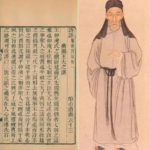Lívia Bernardes Roberge, History PhD student at the Federal University of Minas Gerais (UFMG) and volunteer at Varia Historia, Belo Horizonte, MG, Brazil.
 In “The Creation and Failure of a Bill: Sá da Bandeira and the attempt to regulate Portuguese emigration to Brazil (1835-1843)”, published in Varia Historia (Vol. 35, No. 69), Marina Simões Galvanese, a Social History PhD student at USP, addresses the process of formulation of a bill by Viscount Sá da Bandeira, which eventually was rejected, that aimed at hindering the emigration of Portuguese subjects to Brazil. In her analysis, Galvanese denotes attention to elements such as the meaning of the expression “white slavery”, the motives that drove the Viscount to defending such project, the African slave traffic in the post-abolition context, and the polysemic nature of the concept of emigration in Portugal during that period. With this, the author proposes an understanding of the Portuguese State as a place of dispute, and not of absolute consensus about the topic of emigration.
In “The Creation and Failure of a Bill: Sá da Bandeira and the attempt to regulate Portuguese emigration to Brazil (1835-1843)”, published in Varia Historia (Vol. 35, No. 69), Marina Simões Galvanese, a Social History PhD student at USP, addresses the process of formulation of a bill by Viscount Sá da Bandeira, which eventually was rejected, that aimed at hindering the emigration of Portuguese subjects to Brazil. In her analysis, Galvanese denotes attention to elements such as the meaning of the expression “white slavery”, the motives that drove the Viscount to defending such project, the African slave traffic in the post-abolition context, and the polysemic nature of the concept of emigration in Portugal during that period. With this, the author proposes an understanding of the Portuguese State as a place of dispute, and not of absolute consensus about the topic of emigration.
Galvanese emphasizes the transformations around the concept of “emigration” in nineteenth century Portugal, demonstrating in which way these changes were related with the rejection of the emigration regulation project concerning Portuguese subjects, proposed by the Viscount Sá da Bandeira between 1838 and 1843. Before, the word emigration was linked with the flow of individuals between the metropolis and the colony. Afterwards, it started to be used in order to reference liberals which were running away from absolutism. Later, it was associated with the idea of “white slavery”, in the 1830s, and at last began to be comprehended as a matter of liberty of circulation.
Sá da Bandeira, an important figure of Portuguese liberalism in the nineteenth century, occupied the post of Secretary of Foreign Affairs in the Ministério Setembrista amid the process of abolition of slavery. In this context, reports began to emerge concerning the precarious conditions of travel and work to which Portuguese people who left Portugal for Brazil were being subjected. Once on Brazilian land, they were submitted not only to slave-like work conditions (GONÇALVES, 2017, p. 314) but were also transported in ships that used to bring slaves from Africa to Brazil, which provided unhealthy and overcrowded conditions of travel (ALENCASTRO, 1988). The author then argues that the circulation of these reports began to shape the “white slavery” idea, which was associated with Portuguese emigration.
Thenceforward, the emigration of Portuguese subjects to Brazil started to be negatively perceived by some portions of Portuguese society, who disavowed the subaltern positions that emigrated Portuguese people were occupying in the former colony, which, consequently, was seen as an indicative of change in the social position held by Lusitanians in Brazil: For the rulers of a country which had just lost its principal colony — and which needed to be reconstructed as a nation —, it would be inadmissible for Portuguese subjects to do the same work as African slaves and worse: to be transported in the same form (p. 834).
Besides, in this context, Portugal was trying to send white colonizers to its possessions in Africa, for with the independence of Brazil and the abolition of slavery, the Portuguese’s interests turned to the investment in colonization projects in the African continent. But, in formulating his project, Sá da Bandeira appealed to the idea of white slavery to avoid conflict with the Portuguese Constitution of 1826, which already granted the right of liberty to circulate. Yet, when debated in 1843, the project was refused, under the argument that it was unconstitutional.
Galvanese was successful in characterizing Portuguese politics as having been much more plural than consensual in nature. Besides, the author introduces yet another possible motive for the defeat of Sá da Bandeira’s project: the very transformation of the emigration concept that occurred during the five years that passed between its first draft and the debate that rejected it, which made its content inadequate.
References
ALENCASTRO, L. F. de. Proletários e escravos: imigrantes portugueses e cativos africanos no Rio de Janeiro (1850-1872). Novos estudos CEBRAP, n. 21, p. 29-56, 1988.
GONCALVES, P. C. Escravos e imigrantes são o que importam: fornecimento e controle da mão de obra para a economia agroexportadora Oitocentista. Almanack [online]. 2017, no. 17, pp.307-361, ISSN 2236-4633 [viewed 28 January 2020]. DOI: 10.1590/2236-463320171710. Available from: http://ref.scielo.org/vk7fsj
To read the article, access
GALVANESE, M. S. Criação e fracasso de um projeto Sá da Bandeira e a tentativa de regulamentar a emigração portuguesa para o Brasil (1835-1843). Varia hist. [online]. 2019, vol. 35, no. 69, pp.825-856, ISSN 0104-8775 [viewed 28 January 2020]. DOI: 10.1590/0104-87752019000300006. Available from: http://ref.scielo.org/wq3n68.
External links
Varia Historia – VH: www.scielo.br/vh
Site Varia Historia – www.variahistoria.org
Facebook Varia Historia: https://www.facebook.com/variahistoria/
Twitter Varia Historia: https://twitter.com/variahistoria
Canal Varia Historia: https://www.youtube.com/channel/UCD4EbWEXNyTAirlemvy3UPw
Como citar este post [ISO 690/2010]:














Recent Comments